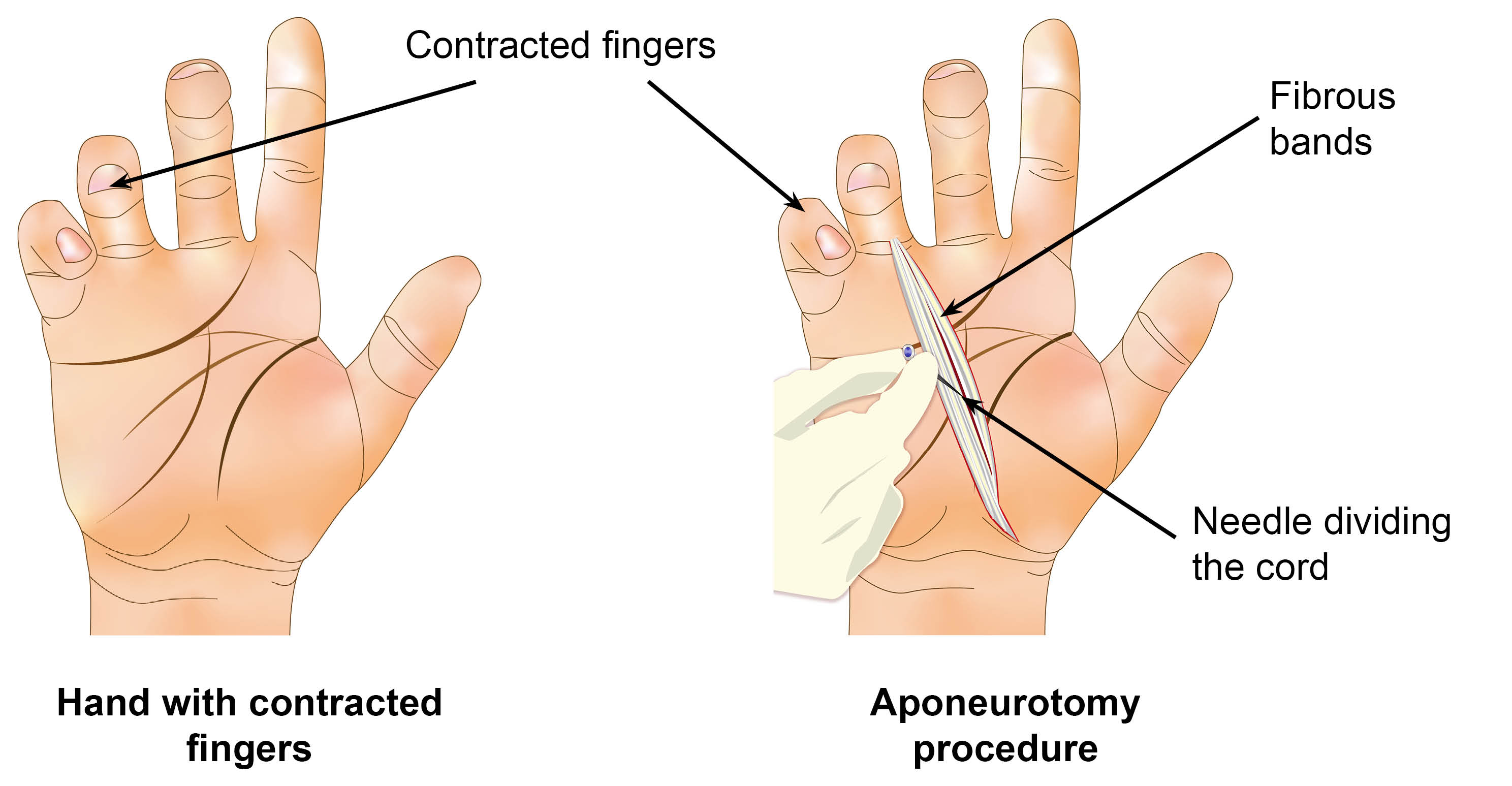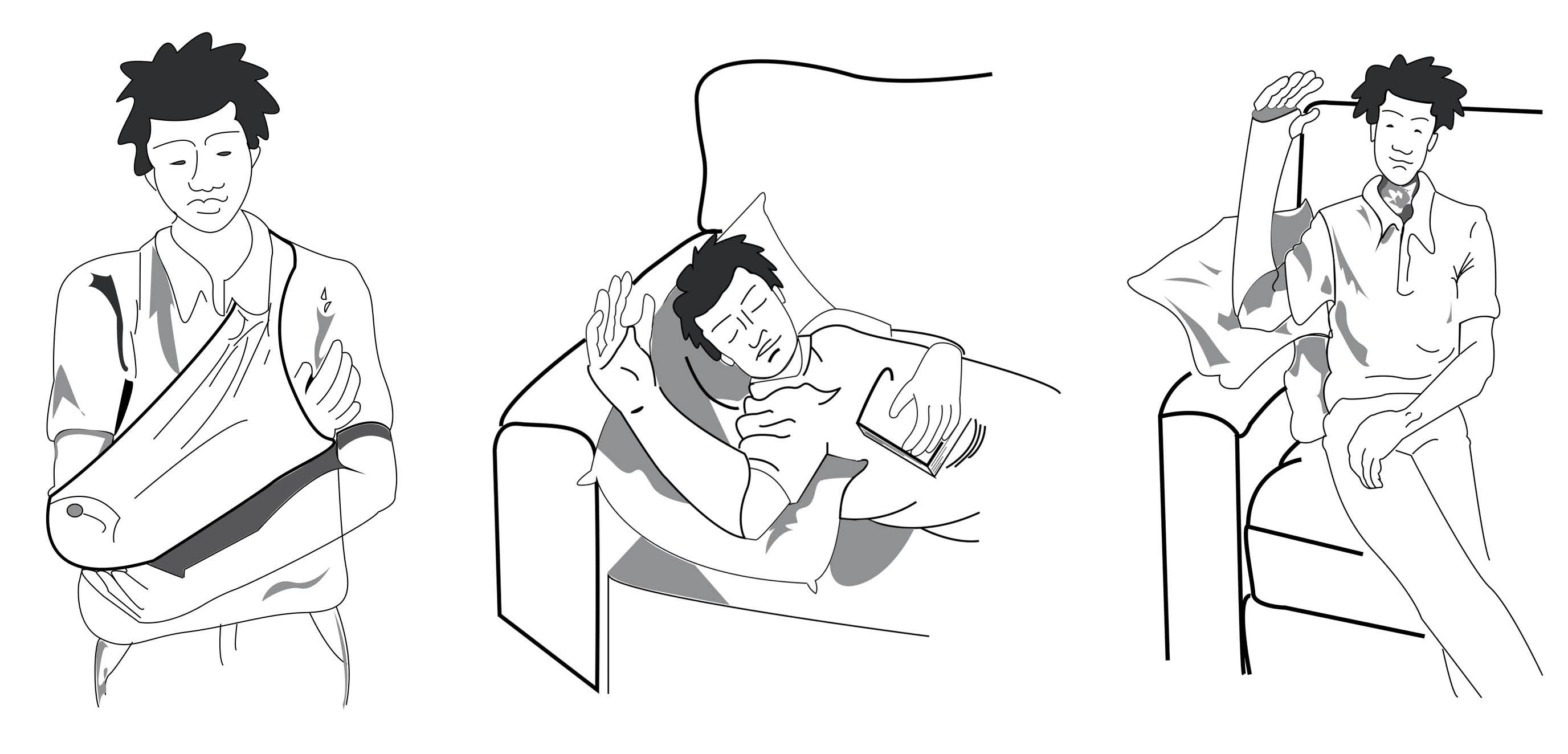Dupuytren's disease: needle aponeurotomy procedure
Information for patients from the Orthopaedic Hand Service
This leaflet provides information with regards to the care of your hand following your surgical procedure to correct Dupuytren’s contracture using a needle aponeurotomy technique, also known as a fasciotomy.
What is a needle aponeurotomy procedure?
During the procedure, a sharp blade or a very fine needle will be inserted into the fibrous bands in the palm of your hand or your fingers. The blade or needle will be used to divide the cord under your skin. By doing this your surgeon will release the tightness in your hand that is forcing your finger to bend.

What are the benefits to having this procedure?
The benefits of needle aponeurotomy include:
your fingers are less deformed
you recover more quickly compared to more extensive surgery
it has a low risk of complications (around one in every 100 patients will have a complication).
Needle aponeurotomy can be suitable for older patients who are unsuitable for surgery; or if the contracture is only affecting the knuckle joint.
What are the risks and possible complications from this procedure?
As with any surgery complications can occur, but with Dupuytren’s contracture they tend to be mild, if they happen at all. Complications can include the following.
Incomplete correction. It may not be possible to fully straighten the finger, particularly if the finger has been bent for a number of years.
Delayed wound healing or infection. A small number of patients may develop an infection and need antibiotics or a wash out procedure (more common in patients with diabetes).Compared to non-smokers, smokers are more likely to have complications in tissue healing and infections after injuries or surgery. For free friendly support and medication to help you stop smoking, contact One You Kent on telephone 03001 231 220, or email.
Nerve injury. The contracted tissue is wrapped around the small nerves in the finger, and as mall number of patients (five to 10 in every 100 patients) may be left with some permanent or temporary loss of feeling along their finger.
Collection of blood or blood clots in the hand tissues (haematoma). This may need a second surgical procedure to remove the blood clot.
Recurrence. Dupuytren’s is a disease and the flexion deformity can affect any of the fingers leading to further surgery. The rate of recurrence for Dupuytren’s contracture is very high: as many as six in every 10 people who have a needle aponeurotomy will have Dupuytren’s contracture again within three to five years. Patients have to be selected carefully to get the best outcome.
Complex regional pain syndrome (CRPS) is a rare condition but can cause severe pain, swelling, and stiffness in the hand. This can take several months to improve or may even continue.
Despite the list of complications and risks, please remember that most patients have an uncomplicated routine procedure with very satisfactory recovery and outcome.
Will I have to stay in hospital overnight?
No. The surgery is a day case procedure, so you will be in the hospital for a few hours only, and can then go home again.
Will I have an anaesthetic?
The surgery is carried out using a local anaesthetic, where only your hand is numbed. You will be awake throughout.
How do I care for my hand after my procedure?
After your procedure, the small wound will be covered with a sticky plaster and a bandage put over this. You must keep your dressings dry.
It is important to keep your hand elevated (raised), above the level of your heart, as much as possible for the first one to two days after your procedure, to reduce any swelling. See images below for examples of good elevation.

After the first two days remove the outer bandage, leaving the sticky plaster in place for a further seven to 10 days.
You may have a dissolvable stitch, which will fall out around 10 to 14 days after your procedure. At that time, when your wound is completely dry and scabbed over, you may wash your hand under a running tap.
What should I do if I feel pain at home?
You may be in a little discomfort and have some bruising after your procedure; this is normal. You may take simple painkillers (such as paracetamol) if you feel it necessary and you are able to take this kind of medication.
However, if you have a large increase in pain after you arrive home and you start to feel unwell, you should contact your GP for advice and pain relief. If this is outside GP hours then go to your nearest Urgent Treatment Centre or Emergency Department. They may need to check your wound and can then advise on further management.
How do I care for my scar?
Once a scar has formed, it may become sensitive to touch while it heals. It is important to massage the scar with a small amount of water based hand cream for up to eight weeks after your procedure. This will help to soften the scar tissue and reduce any sensitivity.
Will I need a follow-up appointment?
Most people do not need an appointment following a needle aponeurotomy procedure; you will discuss this with your surgical team. Details of who to contact in the event of a problem can be found below.
How soon after surgery can I drive?
You can drive as soon as you feel confident enough to control your car safely and you are not in any discomfort. This is usually about a week after your procedure.
When can I return to my normal activities?
You should return to normal everyday activities as your pain allows; often around one to three weeks after your procedure.
When can I return to work?
Returning to work depends on the type of work you do. Someone who does heavy manual work may not be able to return for a few weeks. An office worker may be able to return to light duties a few days after their procedure. The same applies to sport and the type of sport you play.
What if I have any questions or concerns?
If you have any questions or concerns following your surgery, please call the Orthopaedic Hand Service on 01227 708065 and leave a message on the answer phone stating your name and patient number. We will try to return your call within 24 hours (Monday to Friday).